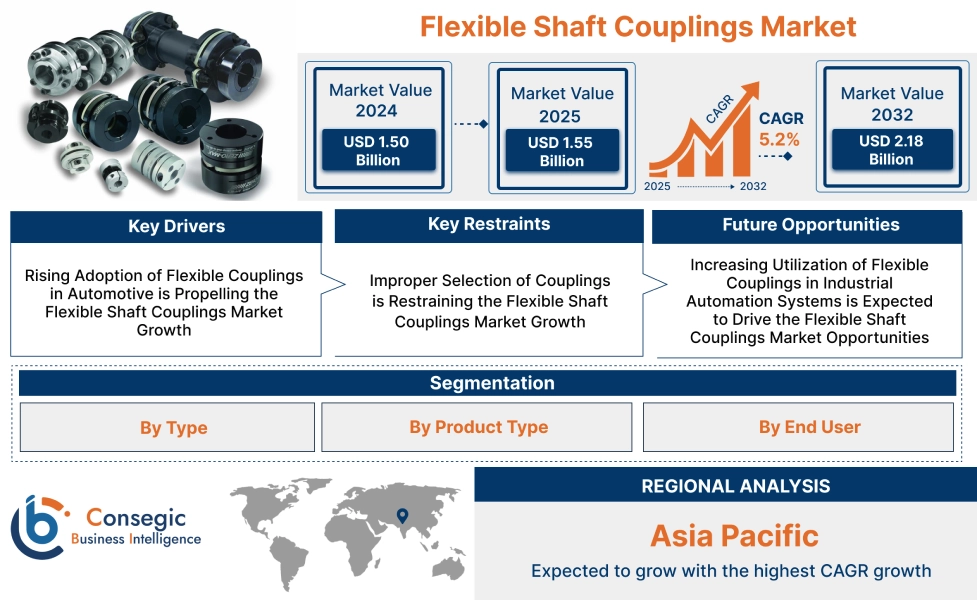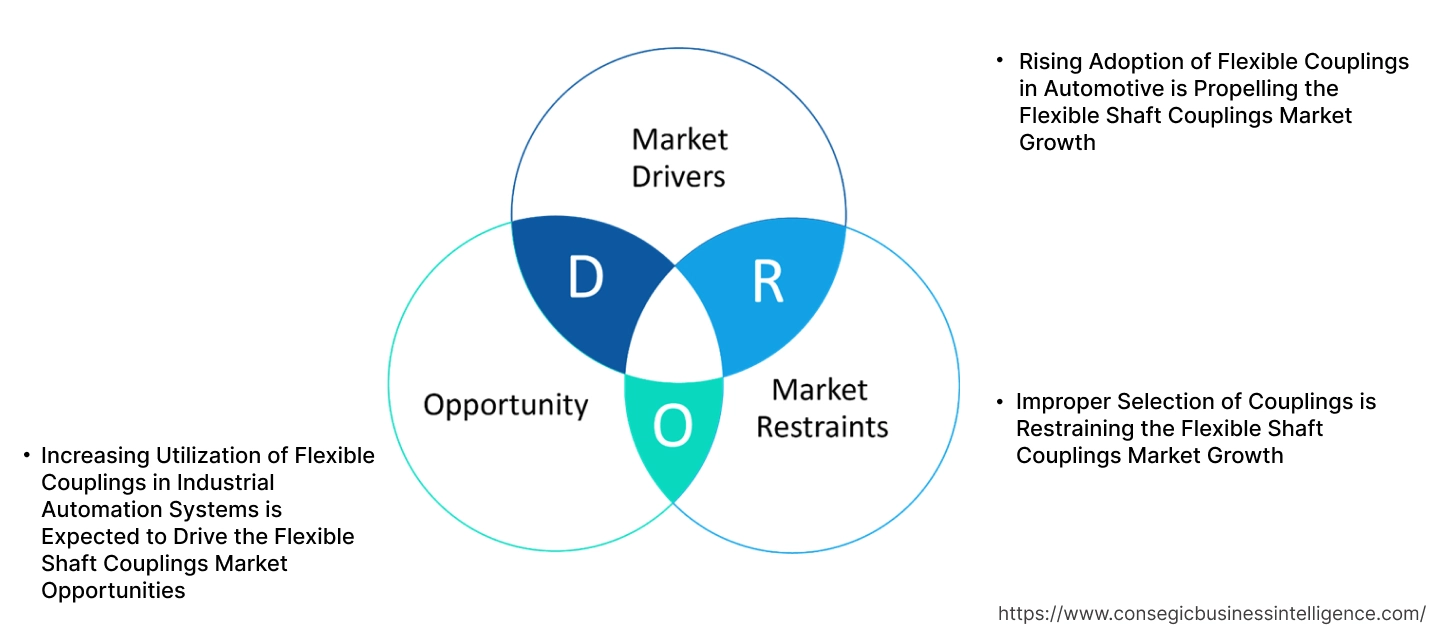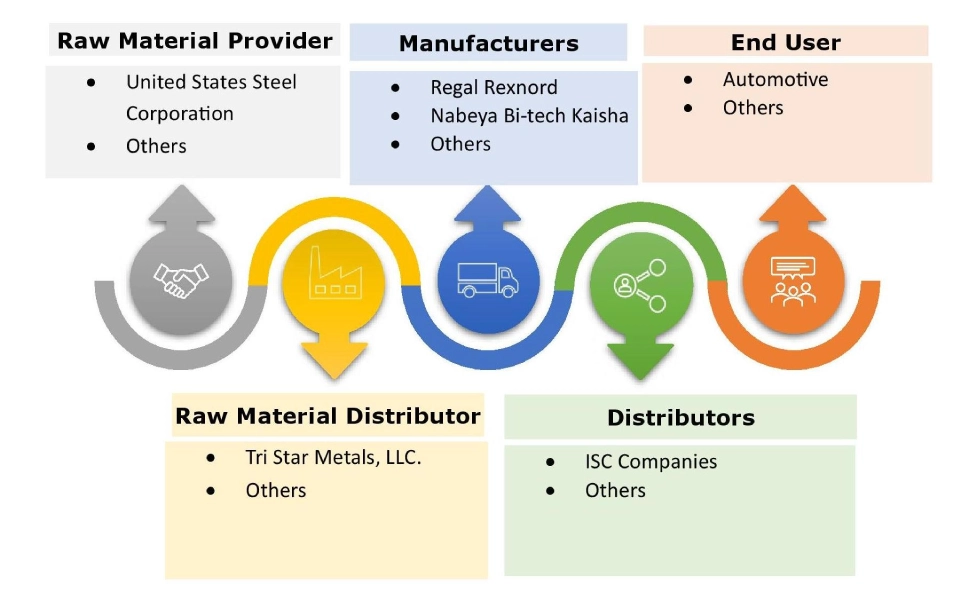Flexible Shaft Couplings Market Size:
Flexible Shaft Couplings Market size is estimated to reach over USD 2.18 Billion by 2032 from a value of USD 1.50 Billion in 2024 and is projected to grow by USD 1.55 Billion in 2025, growing at a CAGR of 5.2% from 2025 to 2032.
Flexible Shaft Couplings Market Scope & Overview:
Flexible shaft couplings refer to mechanical devices that are used to transmit rotational power between two shafts. The couplings are designed to handle large misalignments and minimal impact on machinery. Further, the couplings achieve flexibility by using metal or rubber elements. Moreover, the rising adoption of the couplings in a variety of industries including automotive that feature elastomeric materials for quiet operations and handling of large loads is driving the market.
How is AI Transforming the Flexible Shaft Couplings Market?
AI is impacting the flexible shaft couplings market by improving performance monitoring, predictive maintenance, and design optimization. These couplings, which are vital for transmitting torque while accommodating misalignment, now benefit from AI-enabled sensors that track vibration, torque variations, and wear in real time. Machine learning algorithms analyze this data to predict failures early, reducing unexpected downtime and extending equipment life. In manufacturing, AI supports advanced simulations to design lighter, more durable couplings that enhance efficiency and reliability. Additionally, AI-driven analytics optimize operational settings, ensuring smoother performance in industrial machinery and automotive applications. As industries shift toward smarter, connected systems, AI is driving the evolution of flexible shaft couplings into more intelligent and efficient components worldwide.
Flexible Shaft Couplings Market Dynamics - (DRO) :
Key Drivers:
Rising Adoption of Flexible Couplings in Automotive is Propelling the Flexible Shaft Couplings Market Growth
Flexible couplings are being increasingly used in passenger vehicles due to their long service life. Moreover, the couplings are also utilized for damping transmission shaft resonance in vehicles which is driving the market. Additionally, the couplings are increasingly used for heavy duty vehicles including trucks and buses due to their high rotational stability, which is driving the market.
- For instance,according to the Society of Indian Automobile Manufacturers, the passenger vehicle sales in India stood at about 4.3 million in 2024-25 compared to 4.2 million in 2023-24. The increasing sales of passenger vehicles is driving the market as flexible couplings are utilized in the vehicles to reduce vibrations during driving.
Hence, the increasing utilization of flexible couplings in automotive to dampen transmission shaft resonance is driving the flexible shaft couplings market size.
Key Restraints:
Improper Selection of Couplings is Restraining the Flexible Shaft Couplings Market Growth
Flexible couplings are designed to transmit torque between rotating shafts; however insufficient torque rating can cause the couplings to get damaged. Further, low performance or a wrong type of coupling can impede mechanical performance. Moreover, couplings that are too rigid can create excessive bearing loads that impacts performance and lifespan, which can act as a restraint to the market growth. Thus, improper selection of couplings due to insufficient torque and low performance acts as a restraint to the flexible shaft couplings market expansion.
Future Opportunities :
Increasing Utilization of Flexible Couplings in Industrial Automation Systems is Expected to Drive the Flexible Shaft Couplings Market Opportunities
Industrial automation systems namely conveyor belts and CNC machines utilize flexible couplings to connect rotating shafts. Moreover, the couplings are also utilized for dampening vibrations which is driving the market. Additionally, many manufacturers have started deploying industrial robots in factories to speed up their manufacturing capabilities, which is driving the market as industrial robots use flexible couplings for joint transmission and accuracy positioning.
- For instance,according to the International Federation of Robotics, annual installation of robots in factories reached 541,302 units in the year 2023. Industrial robots utilize flexible couplings to achieve joint transmission which is driving the market.
Thus, the increasing utilization of flexible couplings in industrial automation systems namely conveyor belts and industrial robots is projected to drive the flexible shaft couplings market opportunities during the forecast period.
Flexible Shaft Couplings Market Segmental Analysis :
By Type:
Based on the type, the market is segmented metallic and elastomeric.
Trends in the type:
- Increasing adoption of metallic namely steel and aluminium due to corrosion resistance is driving the flexible shaft couplings market share.
- Rising utilization of elastomeric for heavy duty applications including cranes and hoists is driving the flexible shaft couplings market trends.
Metallic accounted for the largest revenue share in the year 2024.
- Metallic flexible couplings have experienced a rising adoption due to high wear resistance which has resulted in the flexible shaft couplings market expansion.
- Additionally, there has been a rising adoption of metallic couplings in steam turbine units which is driving the global flexible shaft couplings market.
- Moreover, the increasing utilization of metallic flexible couplings due to high pressure resistance and tensile strength is driving the market.
- For instance,ASC Engineered Solutions offers 405 Stainless Steel Flexible Coupling that is designed for aggressive corrosive environments and can withstand pressure of up to 750 psi.
- According to the market analysis, the rising advancements related to metallic due to wear resistance and high pressure resistance is driving the flexible shaft couplings market trends.
Elastomeric is anticipated to register the fastest CAGR during the forecast period.
- There has been a rising adoption of elastomeric to provide quiet-running by eliminating metal to metal contact which is driving the market.
- Moreover, the rising utilization of elastomeric to reduce the magnitude of the imposed loads is boosting the market.
- For instance,Parker Hannifin offers LORD Dynaflex Elastomeric flexible couplings that prolongs drivetrain component life by reducing the magnitude of loads and attenuating vibration.
- Thus, the increasing utilization of elastomeric to provide quiet running and reduce magnitude of the imposed loads is driving the overall market.
By Product Type:
Based on the product type, the market is segmented into beam, bellows, jaw, oldham, diaphragm, and others.
Trends in the product type:
- Increasing adoption of jaw couplings that feature urethane and hytrel elements is driving the market trends.
- There has been a rising utilization of bellows couplings in servo drives which is driving the flexible shaft couplings market demand.
Jaw accounted for the largest revenue share in the year 2024.
- Jaw couplings have experienced a rising adoption for cushioning shock loads which is driving the market.
- Further, the rising utilization of jaw couplings due to ease of installation is driving the flexible shaft couplings market demand.
- Moreover, manufacturers have started offering jaw couplings that feature fail-safe shaft connection which is driving the market.
- For instance,Fenner offers jaw couplings for absorbing incidental misalignment and small amplitude vibrations that features fail-safe shaft connection.
- Thus, as per the analysis, the rising adoption of jaw for cushioning shock loads and absorbing incidental misalignment is driving the market.
Bellows is anticipated to register the fastest CAGR during the forecast period.
- Bellows couplings provide backlash free torque transmission while compensating for lateral, axial, and angular misalignment which is driving the market.
- Moreover, bellows couplings have experienced a rising adoption due to high operating temperature range which is driving the market.
- For instance,DIEQUA offers Series BC flexible metal bellows couplings that feature faster acceleration and deceleration with lower torque and operating temperature range of -30° C to +120° C.
- Therefore, the rising utilization of bellows to provide backlash free torque transmission is driving the market.
By End User:
Based on the end user, the market is segmented into manufacturing, automotive, aerospace, healthcare, power generation, and others.
Trends in the end user:
- Increasing adoption of flexible couplings in manufacturing due to high torsional flexibility is driving the market trends.
- Rising adoption of flexible shaft couplings in automotive due to decreased life cycle costs is driving the market growth.
Manufacturing accounted for the largest revenue share of 32.68% in the year 2024.
- Manufacturing has experienced a rising adoption of flexible couplings that feature high thermal loads which has driven the global flexible shaft couplings market.
- Further, rising utilization of the couplings for both directions of rotation and reversing operation is driving the market demand.
- For instance,Optibelt offers the Orpex flexible couplings that feature a torque of up to 1,300,000 and easy switching of pins and buffers.
- Therefore, the increasing demand for flexible couplings in manufacturing due to integration of reversing operation and high thermal loads is driving the flexible shaft couplings market size.
Automotive is anticipated to register the fastest CAGR during the forecast period.
- Flexible couplings have experienced a growing adoption to provide mechanical flexibility to the driveshaft by allowing a smooth rotation between the shafts which has driven the market.
- Additionally, suspension systems have witnessed a growing adoption of flexible couplings to minimize vibrations which is driving the market.
- Moreover, the rise in the offerings by manufactures that feature a modular design and easy integration in the drive system is driving the growth of the market.
- According to the flexible shaft couplings market analysis, the rising trend in the adoption of flexible couplings in to provide mechanical flexibility to the driveshaft is propelling the flexible shaft couplings industry during the forecast period.

Regional Analysis:
The regions covered are North America, Europe, Asia Pacific, the Middle East and Africa, and Latin America.
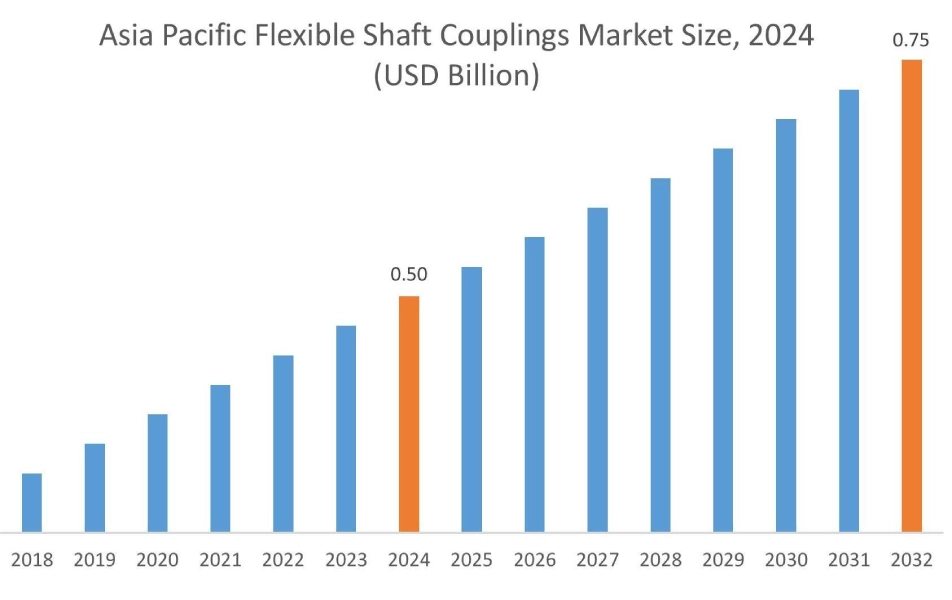
Asia Pacific region was valued at 0.50 Billion in 2024. Moreover, it is projected to grow by 0.52 Billion in 2025 and reach over 0.75 Billion by 2032. Out of this, China accounted for the maximum revenue share of 34.92%. As per the flexible shaft couplings market analysis, the growth in the Asia-Pacific region is primarily driven by the increasing utilization of metallic couplings and rising investments in manufacturing.
- For instance, according to the Ministry of Commerce & Industry, FDI equity inflows in India’s manufacturing sector reached USD 165.1 billion over the past decade (2014-24). The rise in investments in manufacturing is expected to boost the market as flexible couplings are used for shock and vibration absorption in manufacturing.
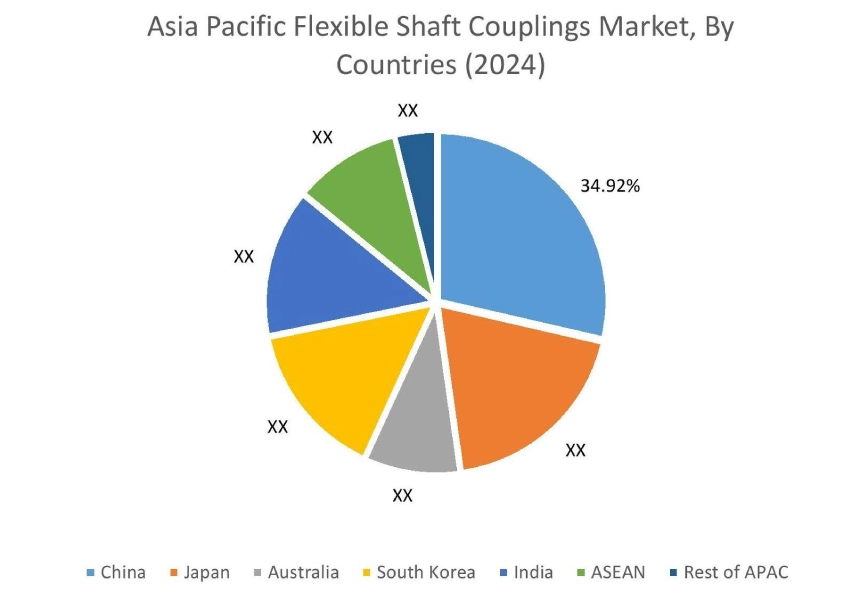
North America is estimated to reach over USD 0.65 Billion by 2032 from a value of USD 0.44 Billion in 2024 and is projected to grow by USD 0.45 Billion in 2025. In North America, the growth of flexible shaft couplings industry is driven by the increasing adoption of beam couplings. Moreover, increasing investments by automotive parts manufacturers has resulted in the rise of flexible shaft couplings market share.
- For instance, in September 2022, S. Tsubaki , announced the acquisition of ATR Sales Inc. Further, U.S. Tsubaki aims to expand its North American Manufacturing Capabilities for industrial couplings through the acquisition. The increasing investments by auto parts companies to scale up manufacturing of flexible couplings is expected to boost the market.
Additionally, the regional analysis depicts that the rising utilization of flexible couplings in the automotive sector is driving the market demand in Europe. Furthermore, as per the market analysis, the market demand in Latin America is expected to grow at a considerable rate due to rising investments in healthcare and medical device production. Middle East and Africa is expected to grow at a considerable rate due to factors such as growing investments by automotive companies and rising investments in aerospace.
Top Key Players and Market Share Insights:
The global flexible shaft couplings market is highly competitive with major players providing solutions to the national and international markets. Key players are adopting several strategies in research and development (R&D), product innovation, and end-user launches to hold a strong position in the flexible shaft couplings market. Key players in the flexible shaft couplings industry include-
- SKF (Sweden)
- KBK Antriebstechnik GmbH (Germany)
- Nabeya Bi-tech Kaisha (Japan)
- RENK Group AG (Germany)
- DieQua Corporation (U.S.)
- Mayr GmbH + Co. KG (Germany)
- Zero-Max, Inc. (U.S.)
- Gates Corporation (U.S.)
- MW Industries (MWI) (U.S.)
- Regal Rexnord (U.S.)
Recent Industry Developments :
Merger and Acquisition
- In March 2025, Ruland Manufacturing, a manufacturer of flexible and rigid couplings announced the acquisition of RoCom Couplings, a company that specializes in beaming technology including beam couplings. Ruland aims to offer a wider portfolio of beamed solutions to its customer base through the acquisition.
Flexible Shaft Couplings Market Report Insights :
| Report Attributes | Report Details |
| Study Timeline | 2019-2032 |
| Market Size in 2032 | USD 2.18 Billion |
| CAGR (2025-2032) | 5.2% |
| By Type |
|
| By Product Type |
|
| By End User |
|
| By Region |
|
| Key Players |
|
| North America | U.S. Canada Mexico |
| Europe | U.K. Germany France Spain Italy Russia Benelux Rest of Europe |
| APAC | China South Korea Japan India Australia ASEAN Rest of Asia-Pacific |
| Middle East and Africa | GCC Turkey South Africa Rest of MEA |
| LATAM | Brazil Argentina Chile Rest of LATAM |
| Report Coverage |
|
Key Questions Answered in the Report
How big is the flexible shaft couplings market? +
The flexible shaft couplings market was valued at USD 1.50 Billion in 2024 and is projected to grow to USD 2.18 Billion by 2032.
Which is the fastest-growing region in the flexible shaft couplings market? +
Asia-Pacific region is experiencing the most rapid growth in the flexible shaft couplings market.
What specific segmentation details are covered in the flexible shaft couplings market report? +
The flexible shaft couplings market report includes type, product type, end user and region.
Who are the major players in the flexible shaft couplings market? +
The key participants in the flexible shaft couplings market are SKF (Sweden), Mayr GmbH + Co. KG (Germany), Zero-Max, Inc. (U.S.), Gates Corporation (U.S.), MW Industries (MWI) (U.S.), Regal Rexnord (U.S.), KBK Antriebstechnik GmbH (Germany), Nabeya Bi-tech Kaisha (Japan), RENK Group AG (Germany), DieQua Corporation (U.S.), and Others.
